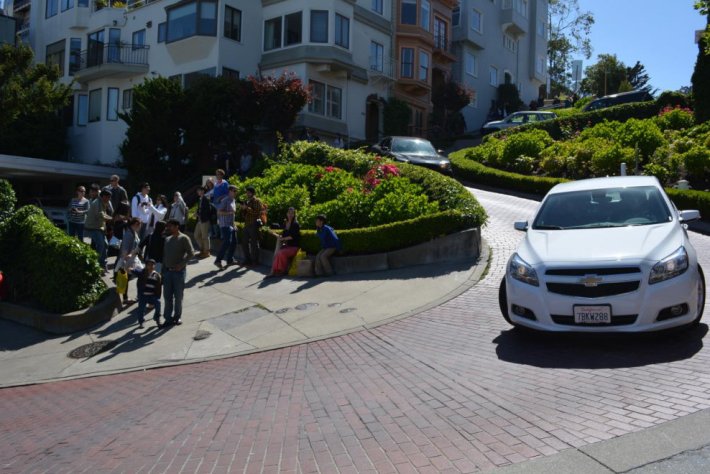
A peculiar thing tends to happen when we talk about streets and transportation: We don't talk about cars. Seriously -- listen to conversations, read news headlines, and you'll start to notice that even when cars are the main subject, people will, consciously or unconsciously, fail to explicitly mention them.
This phenomenon was particularly apparent to me this week, with media coverage of the SFMTA's proposed (and subsequently approved) trial to restrict cars on world-famous crooked Lombard Street. The headlines started pouring out hours after I broke the story with this headline: "SFMTA considers restricting cars on crooked Lombard Street."
Clearly, cars are the key subject of this proposal. It will restrict car access on two blocks, and nothing else. Non-"local" drivers will be banned for some hours on some days over a few weekends, but access for people not in cars -- the vast majority of people on the crooked street -- will actually be made safer and more enjoyable.
Yet from reading headlines found in other news sources around the country, you'd think the street is simply being closed to everyone. Cars are vaguely mentioned, if at all, while the whole "temporary trials on some afternoons" thing often gets washed over, with Lombard deemed simply and totally "closed." Here are a few typical examples:
- Washington Post: "San Francisco to close off iconic Lombard Street to tourists"
- USA Today: "S.F. to temporarily close 'world's crookedest street'"
- SF Chronicle: "Lombard Street to close on 4 busy weekends this summer"
Put simply, unfettered access by cars is equated with "access." If one cannot drive there, one cannot go there. And as those important distinctions are blurred, we lose sight of what we deem important uses of our streets.
The verbal gymnastics used to avoid mentioning cars are present not just in headlines, but in everyday conversation. In discussions about behavior on the streets, notice how often the operators of motor vehicles are described as just "people" -- for example, "People are always flying down this hill." Not that drivers aren't people, but the mode of transport is a key distinction to make. People using other modes usually get explicit labels that posit them as "others" -- people on bikes are "cyclists," and people just walking around are "pedestrians."
The Lombard Street car restrictions have roundly been deemed a "closure," a term with negative connotations. The other side of that action, that of opening the area for people, is ignored -- as is the fact that auto domination is the status quo on San Francisco's streets. Any impingement upon that norm that is framed as a loss.
We've seen this with Sunday Streets. Especially at first, the event was universally described as a "street closure," even though the streets are actually open more than ever, at least to the majority of people not inside a car at any given time. As Sunday Streets has become more normal, and people realize the benefits it brings, I've noticed that it's less frequently described as a "closure."
Another example: What might be most accurately called "car storage" is usually referred to as "parking," and loosely conflated with general quality of life. At community meetings about street redesigns, I typically hear some argue that "the neighborhood" requires parking -- even if they really refer only to that subset of people in the neighborhood who value private automobile storage more than bike lanes and wider sidewalks.
"Traffic" is also typically used interchangeably with "car traffic" (the "car" is omitted). In reality, there is also foot traffic, bicycle traffic, and transit traffic. But when we hear "traffic," it's assumed by default to refer to automobiles, while other means of getting around remain tacitly marginalized.
That usage popped up in the SF Examiner's headline about Lombard: "SF giving twisty Lombard a vacation from traffic." What kind of traffic? Pedestrian traffic will continue to flow freely on the street, but we all somehow know that doesn't count as "traffic."
When the discussion is framed in ways like these, the role cars play is put behind the curtain. The conversation then takes for granted that most public space will be devoted to the private automobile, and most people will travel by car.
If we can't explicitly talk about problems and their causes, we can't talk about fixing them. And if we can't acknowledge the subtle ways in which our lexicon is inherently centered around cars, we can't talk about the ways in which we've adapted our lives, and cities, to accommodate their costs.





